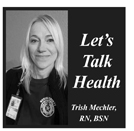Here are the facts. Nearly half of U.S. adults have high blood pressure and about half of those don’t have it under control. Many don’t know they have it and don’t know the damage it is silently causing, and so it gets its name, the silent killer. Family history, race, gender or kidney disease can play a role in our risk factors, and just getting older increases our risk. High blood pressure can contribute to our risk of stroke, heart failure, heart attack, vision loss, kidney disease, sexual dysfunction and plaque buildup in the arteries. It’s also a factor for dementia and Alzheimer’s disease, the most common cause of dementia. Alzheimer’s disease is one of the leading causes of disability and poor health in the US. It is predicted that by 2060 the number of Americans living with Alzheimer’s will double!
My question is who is going to take care of all those people? Consider the increased need for caregivers who will also need to treat their blood pressure due to stress and lack of care for themselves. If reducing my blood pressure means I am reducing my risk for having Alzheimer’s disease that’s enough for me. I’ll be checking it regularly and taking my medication. On the topic of preventing dementia and blood pressure, get some sleep. Research shows your brain is working hard when you sleep, cleaning out toxins. Good sleep habits are important for good health and it’s good for your blood pressure, too! On a positive note, we can change some risk factors that can help lower our blood pressure like avoiding a diet high in sodium, eating real food, regular physical activity, weight control, stop smoking or using tobacco, and cut out or slow down on alcohol use. If you have diabetes, and/or high cholesterol, keep it under control. Aww…the stress culprit. It gets us all! Stress is terrible for our health and our blood pressure. Some risk factors are challenging to tackle but we can do it! A simple start is to get a home blood pressure monitor and keep a record. You can get an automatic one for about $30 and some insurance companies will send you one for free. Check with your doctor on what he/she would like your blood pressure range to be. It could be different for you depending on some factors like if you already have hypertension, what blood pressure medications you are currently taking or even your age. You can check various organizations and get a few different answers here but let’s go with what the American Heart Association (AHA) says. The AHA states the category for normal blood pressure should be less than 120 systolic (the top number) and less than 80 diastolic (the bottom number) so 120/80 or less than that would be normal blood pressure. High blood pressure is considered 140 or higher systolic or 90 or higher diastolic so 140/90 or higher. Only your doctor can diagnose you with hypertension so keeping a log would be helpful for your next appointment. So, what are your risk factors and what can you do about them? It’s always a good day to start some new good health habits or restart some if you’re like me. References: American Heart Association. CDC’s and Alzheimer’s Association: Healthy Brain Initiative State and Local Road Map for Public Health, 2023-2027.
